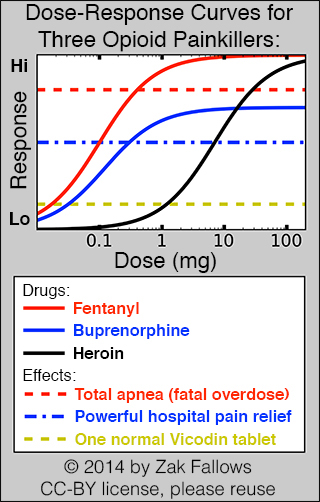
The dose-response curve is probably the most iconic graph from the science of pharmacology. The graph above shows the dose-response curves for three common opioid painkillers. Notice that fentanyl is 70 times more potent than heroin, but addicts and drug abusers generally prefer heroin. Buprenorphine is about 25 times more potent than heroin but it has a lower intrinsic efficacy (IE). As a result, the solid blue buprenorphine line never crosses the dashed red total apnea line. This means that even a massive overdose of buprenorphine will not cause total apnea (total cessation of breathing), so doctors can safely give buprenorphine to recovering addicts. More details on the course home graphic. (Image courtesy of Zak Fallows.) CC-BY.
Instructor(s)
Zak Fallows
MIT Course Number
ES.S10
As Taught In
Spring 2013
Level
Undergraduate
Course Description
Course Features
Educator Features
Course Description
This class is a multidisciplinary introduction to pharmacology, neurotransmitters, drug mechanisms, and brain diseases from addiction to schizophrenia.
From Abilify® to Zyrtec®, the world is full of fascinating drugs. If you are poisoned by sarin nerve gas, you may be able to save your life by huffing some BZ nerve gas. This class will explain that chemical curiosity, along with a host of other interesting tidbits of pharmacology. The structure of the class interleaves basic concepts with specific examples and entertaining tangents, so it is not loaded with boring abstract theory. In the first class you will learn what a neurotransmitter is, and you will immediately apply that knowledge when we discuss the mechanism of caffeine. The class is highly multidisciplinary, including topics such as patent law, medical ethics, history, and the physics of crack pipes.


